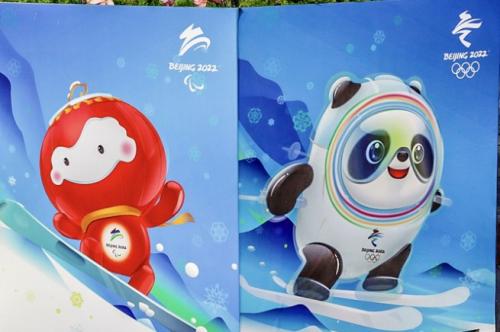



Wangfujing in downtown Beijing is one of the city's well-established shopping streets. Presently, outside Beijing Department Store a tall digital sign counts down the days, minutes and seconds until the 2022 Beijing Winter Olympic Games open. People stand in front of it to be photographed. It reminds me of one such large clock that 14 years ago heralded the approach of Beijing 2008 Olympics. Both represent significant, prestigious moments for the city and indeed China.
I have been fortunate to have been in Beijing for both events. To be out with my camera photographing Olympic-related activities and promotions along with reactions of the people. This year of course is different due to measures aimed at containing the COVID virus from spreading. However, the games will be beamed worldwide showing not only the beauty of mountainous areas north of Beijing but also of how so many people have really taken up the idea of winter sports in a really big way. It's something I'm looking forward to seeing.
Looking back at 2015, I recall some reactions when on July 31, 2015, the International Olympics Committee (IOC) at their 128th session announced Beijing will host the 2022 Winter Games. The first time in Olympic history a city would hostboth summer and winter sessions along with the Paralympics! Quite an achievement.
There were questions of Beijing's, indeed China's, suitability as a winter sports destination.

China covers a vast territorial area that incorporates a wide range of climatic zones. The country's northeastern provinces border Mongolia and eastern areas of Russia, sharing their midwinter extremes. Beijing geographically is where the colder, generally drier north meets the more humid south of the country. The city's average elevation is a mere 52 meters above the sea level yet only 43 kilometers north of downtown, the land starts rising for 27 kilometers up the Juyongguan Pass to where the Great Wall crosses the mountains at Badaling. There, with an average altitude there over 1,000 meters, winter is noticeably colder than downtown.
China is a country that has endured and coped with long hard winters. People's lives seasonally adjusted to the weather extremes. In the far north, frozen rivers and lakes were historically used as "roadways". People fished through holes in the ice, something that can still be seen on some of nearby Tianjin's canals. In northern Heilongjiang, groups who relied on animal herding and hunting developed the use of simple snow shoes, ice skates and improvised skis. Indeed in that province there are villages such as Xue Xiang known today as China's No1 "Snow Town" attracting many thousands of tourists annually.
Ever since coming to China, 35 years ago, I have been aware of the increasing popularity for winter-related activities. During 1992, in subtropical Guangzhou I regularly skated at a busy indoor ice rink near downtown Luhu Park. A great way to cool off from the outdoor heat!
In Beijing, ice skating has long been part of the winter scene at the Shichahai Lake north of the Forbidden City. The popularity of such winter fun and sports extends to Kunming Lake at the Summer Palace, to countless parks and other locations citywide. Low, stable temperatures ensure safe ice conditions. However, since the 1990's indoor ice rinks were and still are facilitating year-round skating at shopping malls such as China World Guomao.
Since the early 2000s skiing has increasingly gained popularity. Beijing has several long-established resorts in the mountainous area north of the city such as in Miyun district and close to the Great Wall.

China has effectively gathered considerable experience not only with managing winter sports but also in hosting what was undoubtedly an excellent Olympics in 2008. To date, winter outdoor activities have mainly attracted domestic followers. However, worldwide audiences will view facilities, pristine conditions and indeed the natural beauty at mountainous Yanqing and Chongli. Hopefully, China will then start attracting international enthusiasts to its prestigious winter venues. Initially, probably from nearby climatically warmer Asian neighbors, and eventually spreading much wider.
An asset for Beijing's resorts is climate. While temperatures do not usually reach the extreme lows found in the far northeast, winters normally are noticeable for generally stable conditions. There is little daily variation due to continental climatic conditions resulting in low humidity, light winds and generally blue skies. A result also is little evaporation or melting of snow, an important asset for skiing resorts.
"Do these areas experience snowfall?" I have been asked. Yes, they do, but nothing in weather is ever guaranteed! Flying during winter from Europe toward Beijing, for example, I remember looking down over the Gobi Desert between Mongolia and China. Snow-covered, frozen and incredibly beautiful. Many years ago, I recall also a January rail journey across that area, the visibility crystal clear, the sky an intense blue contrasting with white of the ground. Snowy landscapes I would see as far south as the Great Wall.
The Olympic skiing areas include Yanqing within a forested setting north of Badaling Pass. Chongli is in a mountainous zone east of historic Zhangjiakou, a city on the main railway line south to Beijing. That city has witnessed considerable infrastructure development in response to the Olympics.

The skiing locations, both in higher altitude areas, reaching between 1,800-2,100 meters above the sea level, should be more likely to have experienced snowfalls with few melting problems. However, prevailing high air-pressure usually result in little or no snow falling during midwinter. Usually the snows come at the beginning and end of winter such as we experience annually in Beijing. This of course has meant the adoption of artificial snow blowing equipment in case of scarcity. Many international skiing areas similarly utilize such facilities, particularly where competitive events are scheduled. During the Games, unless are unexpected temperature changes causing any snow to melt, the blowers are there for maintaining a surface consistency, particularly important for downhill racing events. The present snow base should be stable, having been in place possibly for several months while maintained to the highest international standards.
Sustainability has been a feature of today's Beijing Winter Olympics. There will be considerable use of the latest, high-tech low energy technology. However, there has also been "recycling" on a grand scale. Several venues from 2008 have been repurposed for winter use such as the National Aquatics Centre at the Olympic Green. Formerly a centre for swimming, it will be used for curling events, known affectionately now as the "Ice Cube". The iconic National Stadium will host what should again be a spectacular Opening Ceremony on February 4.
A major achievement has been conversion of the vast, former Shougang Steelworks in the western suburbs of Beijing into the main operational centre for the Games and location of the Ski Jump Platform. Beijing's extensive metro system now links directly into Shougang, allowing ease of access both during the events and long after. Shougang is currently a growing year-round visitor attraction.
Considerable investment has gone into creating the highest level of venues and facilities. This is not a "one-off" project for the Olympics, the aim is much more long term. With superb locations the main downhill skiing areas, Chongli and Yanqing will most certainly become leading winter playgrounds for Beijing, hopefully also receiving international recognition. However, they will also provide summer vacation opportunities.

Recently a major upgrade of rail connections between Beijing and Zhangjiakou has connected the area into the country's high-speed network. A link from the main line led up initially to Taizicheng and recently to Chongli. With a journey time of under an hour and trains uniquely adapted for skiers, this will open up the area to even more winter sports enthusiasts from the capital and beyond. Also during warmer months, for people simply wanting access to the mountains, the resorts offers quality accommodation and dining. Chairlifts and gondolas will continue providing uplift to the slopes.
There is hope also that the forthcoming events will generate even more interest in outdoor activities. Beijing has certainly many excellent locations for such sports. However, Olympic skiing areas, with first class facilities and excellent transport connections will remain a major draw. People today are generally more affluent and so able to afford the costs of weekend sporting breaks.
It is noticeable in Beijing's main shopping malls, for example, that an increasing number of sports clothing stores and brands are focusing on outdoor gear, both for skiing and mountain adventure. I have also witnessed a rise in "guochao" where a new generation of such clothing is incorporating elements of Chinese symbolism. Today snowboards feature prominently in the stores.
It has been unfortunate the Winter Olympics coincide with an ongoing worldwide pandemic creating a unique set of challenges not seen in 2008. The response in China has been well planned to hopefully ensure a safe running of games, safety of participants and of the public in general. Sadly I will miss actually meeting international visitors, for example, on Wangfujing and being able to say "Beijing huanying ni!" ("Welcome to Beijing"). However, it is to be hoped that all visitors will depart with positive impressions of their time here, as they did in 2008.
There are many super-size screens installed across the city so that local residents can watch the activities, which of course will have extensive domestic and indeed worldwide television coverage.

What I have seen so far of preparations for the Winter Olympics looks very impressive and should be positive for the image of Beijing and China. The sporting events coinciding with the Chinese New Year will make for a fascinating time for many of us in Beijing.
The world has come through many difficulties and challenges, particularly over the past two years. Hopefully an outcome of a successful Winter Olympics and Paralympic Games in Beijing will be in words of its motto, "Together for a shared future."



If you have any problems with this article, please contact us at app@chinadaily.com.cn and we'll immediately get back to you.